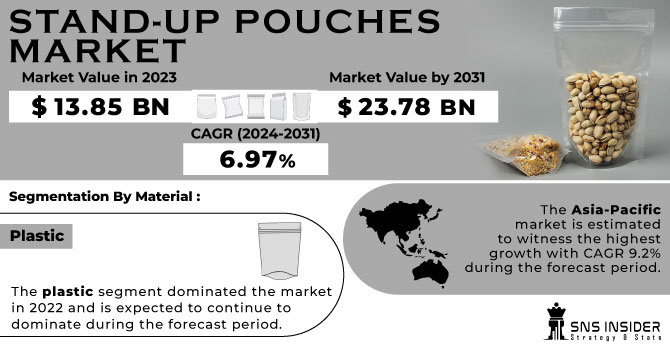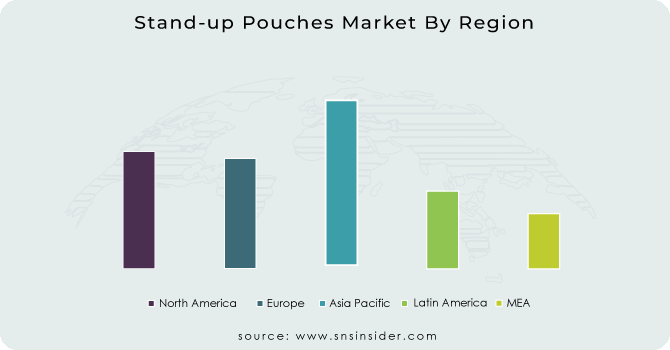Stand-up Pouches Market Key Insights:
The Stand-up Pouches Market size was USD 13.85 billion in 2023 and is expected to Reach USD 23.78 billion by 2031 and grow at a CAGR of 6.97 % over the forecast period of 2024-2031.
Increasing demand for packaged goods is expected to drive market growth. Consumers are showing their preference for stand up pouches due to various features such as convenience is also giving boost to the market.

Get More Information on Stand-up Pouches Market - Request Sample Report
Stand up pouches offer a number of benefits such as better aesthetics along with a number of value-added features including zippers or sliders, spout and tear grooves among others that offer high convenience and functionality. than . In addition, these bags use less material, require lower shipping and handling costs, and are light in weight compared to some other rigid forms of packaging such as glass boxes and bottles, and another form.
The increase in demand for packaged products and the use of packaging due to their features such as zippers or sliders, faucets and tear grooves, among other things, provide convenience and functionality. Higher capacity are the main factors driving the stand up bag market. Increasing demand for packaged products, increasing consumer trend towards stand up pouches due to factors such as convenience, aesthetics and several value-added features as well as limited requirements in terms of material, shipping and handling costs are driving the growth of stand up pouches.
On the other hand, volatile raw material prices and strict implementation of government regulations are the factors that are expected to hinder the growth of the stand up pouch market. Issues related to the recycling of laminated structures and the availability of substitutes are expected to challenge the stand up bags market during the forecast period.
On the basis of materials, the market has been segmented into plastic, paper, metal and bioplastic. Plastics are mainly used for the production of films and laminates are widely used for the production of stand-up bags. The plastic segment dominated the market in 2022 and is expected to continue to dominate during the forecast period.
Common plastics used to make these bags include polyethylene polypropylene, polyethylene terephthalate, polyamide, and polyvinyl chloride, among others. Block bottom bags are made from a single plastic material or a combination of different layers of plastic. Plastic is an economical, durable and lightweight material therefore it is widely used for the manufacture of products.
The bioplastic materials segment is expected to witness the highest growth rate during the forecast period. Growing environmental concerns over plastic waste are expected to increase the use of bioplastics during the forecast period, thus benefiting the growth of this segment. On the other hand, paper is also widely used to make stand up bags due to the increasing focus on sustainability.
Based on Product type, the market has been segmented into standard, autoclave and hot filled. The standard type segment dominated the market in 2022 and is expected to continue during the forecast period. However, retort flat bottom bag segment is expected to witness the highest growth rate during the forecast period.
Based on Closure Type, the mining segment is expected to witness the highest growth rate during the forecast period. This closure consists of a tube attached to the bag through which substances such as liquids and pastes can be poured. They offer a number of advantages including easy opening and closing as well as more convenience when emptying the product into the bag.
Based on Application Type, the use of stand up bags is increasing in the packaging of food products such as ready meals, breakfast cereals, cereals, gourmet products, frozen fruits and vegetables, frozen fruit powders, etc. refrigeration, etc., is expected to drive demand for the product beyond the forecast period. . In addition, flat bottom bags are also commonly used to pack some beverage products including flavored juices, energy drinks, teas and coffees, etc.
MARKET DYNAMICS
KEY DRIVERS:
-
The rise in consumer demand for food and beverage products.
Growing consumer demand for convenient, on-the-go food and beverage products has contributed to the increased use of stand-up bags. These bags are widely used to pack snacks, pet food, baby food, sauces, drinks, and other products that need easy access and movement. According to ASSOCHAM, in India there has been rise of 40 % on annual spending on packaged food products.
-
Continuous innovation and advancements in Packaging Technology have given rise for adoption of stand-up pouches.
RESTRAIN:
-
Various regulations and Standards related to stand-up packaging are restraining the growth of the market.
Managing business with these regulations can pose challenges and add complexity to the manufacturing and distribution processes. For example, in Asian region restrictions on the use of certain materials or additives may impact the design and functionality of stand-up pouches.
OPPORTUNITY:
-
Increasing Demand for Sustainable Packaging
As consumers and governments increasingly focus on sustainability, the demand for eco-friendly packaging solutions is increasing. Stand-up pouches could take advantage of this trend by making them even more recyclable and incorporating bio-based or compostable materials. The development of sustainable stand-up pouches will attract environmentally conscious consumers and help brands reach their sustainability goals.
-
Emerging economies and regions such as Latin America, and Africa offer significant growth opportunities.
CHALLENGES:
-
Recycling and Waste Management of Stand-up pouches especially recycling multilayer structures is challenging
Multilayer packaging is not recyclable most of the times. Despite efforts to improve the recyclability of stand-up pouches, flexible packaging recycling infrastructure and facilities remain limited in many regions. The complex multi-layer construction and mix of materials used in stand-up pouches can make recycling more difficult. Addressing these challenges and establishing an effective stand-up pouch recycling and waste management system is essential for sustainable growth.
IMPACT OF RUSSIA-UKRAINE WAR
Russia Ukraine war had a negative impact globally especially on European region. Russia is the major supplier of raw materials such as PET, PE and metals such as aluminium. Nearly about 5.5 million fled from Ukraine after conflict. 300 major companies stopped operating and suspended their investments in Russia. Ukraine major exporter of PET stopped the exports due to which many packaging and production facilities were affected.
A sharp rise was seen in aluminium and paper due to the conflict which is majorly required for the stand-up pouches. Before the conflict began aluminium prices stood at $2800/tonne which after the conflict went up to $4100/tonne. This had an huge impact on production. Along with this, oil and gas prices were hiked which is main source of energy for operations of production facility.
Overall, trade disruptions across the region was major challenge during the conflict. Russia is the third largest exporter for crude oil, which is further used for many industries, packaging is one of them. Most of the plastic is made from petrochemical, there was drop in production across the globe which has an indirect effect on market for stand-up pouches.
IMPACT OF ONGOING RECESSION
Healthcare sector is recession proof, so it will not affect the demand for stand-up pouches. Recession will affect the sales of packaged foods and beverages at a certain level. But healthcare sector will provide growth to the market balancing the negative effect of recession on other sectors.
Stand up pouches are mostly used in food and beverage sector. Recession brings with him negative GDP, rising unemployment and lower consumer spending. During a recession, consumers tighten their priorities and cut spending. When sales decline, companies typically cut costs, lower prices, and postpone new investments.
KEY MARKET SEGMENTATION
By Material
-
Plastic
-
Paper
-
Bioplastic
-
Metal
-
Others
By Product Type
-
Aseptic
-
Retort
-
Hot-Filled
-
Standard
By Closure Type
-
Spout
-
Top Notch
-
Zipper
By Form
-
Round Bottom
-
K-Style
-
Flat Bottom
-
Roll Stock
-
Others
By Application
-
Pet Food
-
Food & Beverages
-
Homecare
-
Healthcare
-
Others
REGIONAL ANALYSIS
The Asia-Pacific market is estimated to witness the highest growth with CAGR 9.2%, during the forecast period. Factors such as changing lifestyles , growing demand for convenient packaging and increasing consumer purchasing power are expected to drive demand for the product during this period. forecast period.
The North American region is expected to witness a growth rate of over 8 % during the forecast period. Factors such as high demand for packaged foods such as ready meals coupled with the growing popularity of stand-up pouches due to their availability, portability, lightness and reduced use of materials compared to other stand-up pouches. hard-packed products are expected to boost market growth in the coming time. forecast period.
European market will show significant growth for the stand-up pouches over the period due to consumer growing preference in this region. Furthermore, the increasing use of stand up pouches by CPG manufacturers due to their aesthetic and marketing benefits is even more likely to drive the market up.

Get Customized Report as per your Business Requirement - Request For Customized Report
REGIONAL COVERAGE:
North America
-
US
-
Canada
-
Mexico
Europe
-
Eastern Europe
-
Poland
-
Romania
-
Hungary
-
Turkey
-
Rest of Eastern Europe
-
-
Western Europe
-
Germany
-
France
-
UK
-
Italy
-
Spain
-
Netherlands
-
Switzerland
-
Austria
-
Rest of Western Europe
-
Asia Pacific
-
China
-
India
-
Japan
-
South Korea
-
Vietnam
-
Singapore
-
Australia
-
Rest of Asia Pacific
Middle East & Africa
-
Middle East
-
UAE
-
Egypt
-
Saudi Arabia
-
Qatar
-
Rest of Middle East
-
-
Africa
-
Nigeria
-
South Africa
-
Rest of Africa
-
Latin America
-
Brazil
-
Argentina
-
Colombia
-
Rest of Latin America
Key players
Some major key players in the Stand up Pouches market are Mondi, Huhtamaki Group, ProAmpac, Amcor plc, Hood Packaging Corporation, Sonoco Products Company, Smurfit Kappa, Clondalkin Group, Sealed Air, Winpak Ltd and other players.
Huhtamaki Group-Company Financial Analysis

RECENT DEVELOPMENTS
-
TotalEnergies, has partnered COLINES, to develop non-laminated and recyclable stand-up pouch.
-
Mespack and Hoffer, have launched spouts and caps made from a single layer of material that uses "20% less" plastic.
| Report Attributes | Details |
| Market Size in 2023 | US$ 13.85 Bn |
| Market Size by 2031 | US$ 23.78 Bn |
| CAGR | CAGR of 6.97% From 2024 to 2031 |
| Base Year | 2023 |
| Forecast Period | 2024-2031 |
| Historical Data | 2020-2022 |
| Report Scope & Coverage | Market Size, Segments Analysis, Competitive Landscape, Regional Analysis, DROC & SWOT Analysis, Forecast Outlook |
| Key Segments | • By Material (Plastic, Paper, Bioplastic, Metal, Others) • By Product Type (Aseptic, Retort, Hot-Filled, Standard) • By Closure Type (Spout, Top Notch, Zipper) • By Form (Round Bottom, K-Style, Flat Bottom, Roll Stock, Others) • By Application (Pet Food, Food & Beverages, Homecare, Healthcare, Others) |
| Regional Analysis/Coverage | North America (US, Canada, Mexico), Europe (Eastern Europe [Poland, Romania, Hungary, Turkey, Rest of Eastern Europe] Western Europe] Germany, France, UK, Italy, Spain, Netherlands, Switzerland, Austria, Rest of Western Europe]). Asia Pacific (China, India, Japan, South Korea, Vietnam, Singapore, Australia, Rest of Asia Pacific), Middle East & Africa (Middle East [UAE, Egypt, Saudi Arabia, Qatar, Rest of Middle East], Africa [Nigeria, South Africa, Rest of Africa], Latin America (Brazil, Argentina, Colombia Rest of Latin America) |
| Company Profiles | Mondi, Huhtamaki Group, ProAmpac, Amcor plc, Hood Packaging Corporation, Sonoco Products Company, Smurfit Kappa, Clondalkin Group, Sealed Air, Winpak Ltd |
| Key Drivers | • The rise in consumer demand for food and beverage products • Continuous innovation and advancements in Packaging Technology has given rise for adoption of stand-up pouches. |
| Market Restraints | • Various regulations and Standards related to stand-up packaging are restraining the growth of market |

